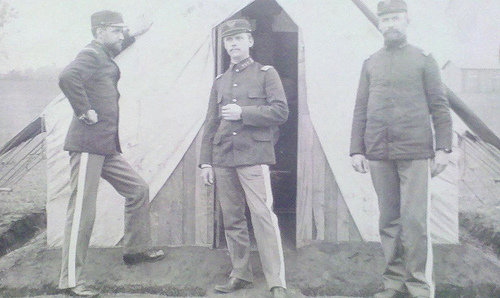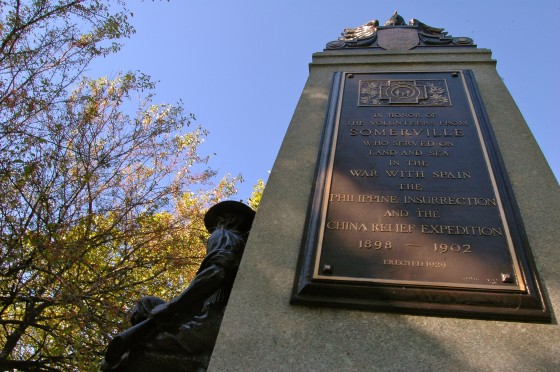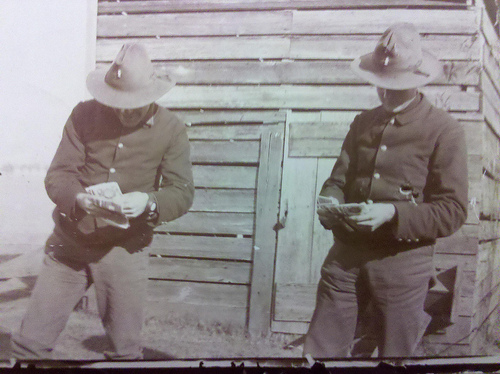In front of the Somerville Central Library sits a monument dedicated “In honor of the volunteers from Somerville who served on land and sea in the War With Spain, the Philippine Insurrection, and the China Relief Expedition.
It’s an odd mix of conflicts; all footnotes among two centuries (and counting) of the United States at war. The context on the monument itself is minimal, with the tiny print on the bottom of the plaque saying only that the monument was put up in 1929.
An informal survey suggested the average Somerville resident had not only never noticed the monument, they also had no idea when or why we went to war with Spain, nor what we were doing suppressing Filipinos and “relieving” people in China. It seemed some research was in order. Local History Librarian Kevin O’Kelly dug up an impressive amount of useful books and documents, including a lottery ticket from Havana, Cuba belonging to Second Lieutenant Frederic W. Pierce of Somerville Company M.
So far, I haven’t found information about any of the Somerville residents who served in the naval actions in China and the Philippines, but I did manage to trace a fairly clear picture of Somerville’s role in the Spanish-American War of 1898.
A War Waged in the Interests of Humanity: An Oversimplification of Why We Went to War with Spain
“A situation will be presented in which our obligation to the sovereignty of Spain will be superseded by higher obligations which we can hardly hesitate to recognize and discharge.”
President Cleveland, 1896
In 1898 Cuba was still a colony of Spain. Washington had economic and security concerns with Cuba, but the issue making sensational headlines in newspapers across the country was the reports of Spanish atrocities against Cuban revolutionaries. Tensions ratcheted up until eventually President McKinley decided to send the USS Maine down to Havana in order to protect American citizens and business interests. The Maine mysteriously exploded and sank in Havana harbor and newspapers began calling for war with the headline “Remember the Maine.” The American public was outraged and war was on.
The Army was undermanned, but the popularity of the war meant that there was a glut of volunteers to go fight Spain. The 8th Infantry Regiment of the Massachusetts National Guard enrolled, and Company M marched out of Somerville with crowds cheering and waving.
War Fever: Enduring Unsanitary Conditions for Uncle Sam
“The excitement of battle and the example of brave men have made a hero of many a man who but for that would have run away. But in a typhoid fever camp death lurks everywhere and there is no stimulating excitement to strengthen those who have to face it. Therefore the highest honors should not be given solely to those soldiers who are so fortunate to do their duty under fire, but to those as well who do their duty wherever they may be, regardless of consequences, and in all the circumstances that may attend them.”
Major General J.P. Spanger, U.S.A., Commanding officer of the Mass 8th

Officers of Somerville Company M, MA 8th Volunteer Regiment, left to right: Lt. George Confield, Capt. Whitten, Lt. F.W. Pierce
The Army couldn’t wrangle all of the new soldiers to the front immediately and Company M found themselves waiting in a huge camp in Georgia called Chickamauga Park with thousands of other eager volunteers. Six to eight men lived in muddy tents for months on end, and conditions rapidly became unsanitary. Before long, men began to get sick. Typhoid fever swept through the camp in epidemic levels and the hospital tents filled up with sick soldiers. Worried family members back in Somerville sent care packages with letters, sweets, and knit socks.
While Somerville Company M waited in muddy misery, hoping for their chance to go help the Cuban people throw off the colonial yoke, the war was being fought somewhere else. The U.S. Navy took the Philippines and Guam from the Spanish in the Pacific and bloodied the Spanish fleet in the Atlantic. 15,000 American troops, including Theodore Roosevelt and his glorified Rough Riders, fought Spanish forces in Cuba at El Caney and San Juan Hill. When the U.S. Army began withdrawing from Cuba on August 7th, 1898, Company M’s 8th Regiment was still sitting in camp, waiting for marching orders.
Conditions in the Army camps improved as sanitary measures were taken, including forcing the men to bathe twice per week and scouring public bathrooms with chloride lime. Unfortunately, before the 8th Regiment finally deployed to Cuba, one in eight enlisted men had been hospitalized and two men from Somerville had been killed by typhoid fever in Chickamauga Park: Sergeant Frank E. Draper and Corporal Clarence Stewart. Private Ernest W. Hunt had apparently had enough by July and deserted.
The Spanish government sued for peace and the Massachusetts 8th Regiment was sent to the Cuban city of Matanzas on a humanitarian mission. There they applied the lessons they had learned in Chickamauga and performed a thorough overhaul of the Matanzas sanitary system. They gave out food, busted unions, clothed children, and kept the peace. When the 8th got on a ship destined for Boston on April 4th, 1889, they left with the mayor’s thanks, never having fired a shot in the heat of combat.
Welcome Home … Oops
“You are returning to your beloved homes. Return then; There love, friendship, and hope await you. Speed you, and be happy there, you who have accomplished in Cuba the greatest moral and material undertaking of the 19th century. There you will be able to hold up your heads among the great and good; for great and noble also are those who there have contributed to the glory of the homeland. Believe therefore, and be assured that you leave friends here, brethren whose gratitude will ever cause them to love and bless you. Farewell!”
Alfred O. Carnot, Mayor of Matanzas, Cuba
Company M arrived home in Somerville and found… nobody. The armory where they were supposed to muster out was locked and deserted; they had to fetch the police to force the doors. Company M gave three cheers for city and company, then wandered back to their homes.
When Somerville finally realized that the soldiers were back, sheepish city officials organized a parade and did their best to make up for flubbing Company M’s homecoming. The Knights of the Sacred Heart, Somerville Veteran Firemen’s Association, assorted bands, the company of letter carriers, and carriages full of city officials all turned out to have a proper parade and make speeches. There was a banquet, then prominent city officials had another round of speeches for good measure.
30 Years Later: Sorry About That!
December 1929, perhaps still feeling somewhat guilty over the whole homecoming debacle, Somerville dedicated a modest monument to local veterans of the Spanish War and associated conflicts. Raymond Porter sculpted the statues and T.F. McGann and sons did the casting (and put their name on the plaque) and the monument was erected in front of the Central Library at Highland Avenue and Walnut Street.
Spanish-American War veterans from all around the area came to march in the snow and see the monument dedicated. The strings were pulled by Lieutenant Frank Draper, father of Sergeant Frank Draper, and Arthur Stewart, brother of Corporal Clarence Stewart. The Somerville Journal does not mention if relatives of Private Hunt were in attendance.
City officials dedicated the monument with suitably solemn speeches.
——————————–
If you want to read more about the exciting adventures of Company M, I recommend Tweleve Months With the Eigth Massachusettes Infantry in the Service of the United States by Harry E. Webber. Just ask the librarian at the upstairs desk in the Somerville Central Library to help you find the book in the local history room.


{ 3 comments… read them below or add one }
Brilliant! Look at those pictures of Old Dudes! We have a local history room at the library?
Also, I might print this out and give it to the 16-year olds who conglomerate by this very statue during/after school to smoke pot and tease each other. “Remember Company M, kiddos. They didn’t get a parade in a timely fashion.”
I’m only partway done reading this, but yay Dave! So far, awesome. Also: I mostly am commenting because you used your library, and that makes me so happy!!!! 😀
Great job Dave! That was very interesting and I look forward to more articles like that one.